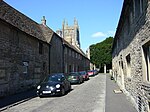Mells Park

Mells Park is a country estate of 140 hectares (350 acres) near Mells, Somerset, England. It originated as a 17th-century deer park, probably created by the Horner family, who had been the owners of Mells Manor from 1543. The Horners expanded the park and planted extensive woodlands, resulting in a large collection of mature trees, especially 18th-century plantings of oak, lime and beech. The park is Grade II listed in the National Register of Historic Parks and Gardens. It contains Park House, also known as Mells Park House, a Grade II* listed building, built in 1925 in neoclassical style by the architect Edwin Lutyens, replacing an 18th-century house of the same name. It is c. 1 mile (1.6 km) west of Mells Manor House, which does not lie within the park.During 1987–90, Park House was used for secret negotiations between the African National Congress and the South African government. The estate is a venue for game shooting.
Excerpt from the Wikipedia article Mells Park (License: CC BY-SA 3.0, Authors, Images).Mells Park
Pople's Lane,
Geographical coordinates (GPS) Address Nearby Places Show on map
Geographical coordinates (GPS)
| Latitude | Longitude |
|---|---|
| N 51.236666666667 ° | E -2.4122222222222 ° |
Address
Park House
Pople's Lane
BA11 3RF , Mells
England, United Kingdom
Open on Google Maps








